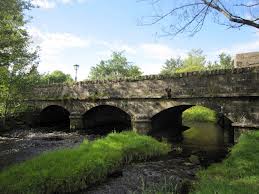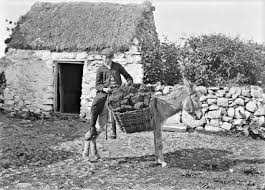Poítín Recipe
Ingredients:
- Granulated Sugar – several stones
- Yeast – a few pounds of the stuff
- Spring Water – gallons and gallons
- For a pleasant change, try an alternative malt and barley mixture, plus yeast, in the same secret quantities.
Get an old barrel and make sure that it is washed out properly. Then melt the sugar but don’t let it burn. The sugar semi-liquifies as it begins to melt. Place the yeast in another container or bowl and break it up with your hands.
Heat the barrel with a drop of hot water. When heated, put a fistful of yeast into the barrel and then pour in some lukewarm water on top of it. Add a good dollop of melted sugar. Throw a wet cloth on top of the barrel and let the sugar and yeast dissolve into the water. The cloth helps to keep the smell down, which is very important.
Place the barrel in a secret dry place. Put hay all around it, including under it, and over the top. Leave it like this for three days. When you go back to the secret place after three days, repeat the same procedure over again, in the same way you did it before, with the yeast, sugar and lukewarm water. Keep doing this over and over, over several weeks, until the barrel is almost full. You now have a wash.
 When the mixture is ready, thin it out with water, preferably potato water. For added flavour, put a bit of treacle through it. This crucial preparation stage is now complete, and the mixture is ready to run.
When the mixture is ready, thin it out with water, preferably potato water. For added flavour, put a bit of treacle through it. This crucial preparation stage is now complete, and the mixture is ready to run.
To run it you will need a steel drum with a lid, copper piping plus a basin with a hole in it. The hole must be the exact same diameter as the copper pipe – because the end of the pipe is pushed neatly through the hole. A worm is also needed and placed into the drum. Always ensure that your drum and worm are thoroughly clean.
Heat the drum gently on a turf fire, and watch as the steam turns magically into whiskey, in the form of a totally clear water-like liquid. Continue running your mixture very gently. When the running is near to completion, gather your whiskey from the still and worm, and then put it back into the top drum one more time and run it again.
When cooled, drink in moderation with your appreciative neighbours – but only after treating the fairies. It would be a pity to be cursed for the rest of your life, after all that patience and endeavour.
If you opt for the malt and barely alternative, there is a lot more hard work involved. Say, you had four stones of malt and barley, then you would have to leave it in water for about three weeks until buds appear. Next, you throw the mixture out onto a dry loft and you have to keep tossing it every day. Do this until the bud goes back into the seed. Finally, you crush the seeds and then put them into the wash barrel with some yeast and lukewarm spring water. The extended process is worthwhile. You will be rewarded with a spirit which your neighbours will declare is ‘The Best of Whiskey’.
Quality Control
To test the success of your distilling skills, light a small piece of paper and put it into a small sample glass of the liquid (whiskey). When it stops burning, the remaining liquid should only be pure water. If there is a good flame burning from the liquid, that suggests that it is a good whiskey, and can be classed as Mountain Dew. Also check that a nob of butter sinks in your filled whiskey glass. If the butter floats on top, then you still have too much water content and you should return to the still and run away.
A surefire way of testing the alcohol strength of your brew is to boil the whiskey and then let it cool off. When the bead on top is not too strong, run it another time and throw some salt into it. If big bubbles appear at the top of the whiskey, it is strong stuff. This spirit is categorized as Mad Man’s Soup; true poítín.
Always, ALWAYS, throw the first drop of poítín to the fairies. Otherwise, supernatural beings will haunt your furtive drinking session. In modern parlance, this is called “hallucination”.
Various Uses for Poítín:
Never let poítín into the wrong hands. Share discreetly at local weddings or for a wake house or with someone who is sick – but never let it into the wrong hands. Your livestock will appreciate a drop as well. To liven up your cattle, mix it with milk and let them slurp away. Poítín is particularly beneficial for people with Arthritis or Sciatica or pains in their knees. For additional pain relief, use internally and externally. Rub the poítín into the affected area. The first run of whiskey is considered the best for aches and pains, or maybe you just don’t feel anything when you sample the second or third runs.
Transportation:
Distribution of your excess whiskey for commercial gain is fraught with danger. When caught on the road, Master Distillers of old were rarely transported overseas, but the County Court Judge will impose hefty financial penalties in the knowledge that your neighbours and customers will stump up a few quid in order to ensure that the still is removed to an even more secret place. Use vigilance and cunning. Here’s an example from our parish:
In the troubled times of 1921, an old woman used to bring Póítín into Tubbercurry and sell it to the big shots in town. She was a mighty woman. The ruthless Black ‘n’ Tans were around at that time; and they used to hold people up on the road, checking their carts. Our heroic old lady used to transport the poítín in kettles. She would fill the top of the spout and seal the lids on each kettle with buttermilk. The soldiers would ask her what was in these kettles and she would reply, “Can you not see that it is buttermilk which I sell to the poor people at the Tubbercurry market each week.” She was known to have one of the most popular stalls on the market, so the local army sergeant was suspicious.
One time, the soldiers followed her out of her village, on her way to Tubbercurry, intending to conduct a thorough search of her cart, away from the busy main road where rebel youths stoned the Brits if they hassled the old locals too much. Word of the soldiers’ presence in the parish was quickly passed to the farmers up the lanes, and a baying mob attempted to delay the platoon as it marched behind the old lady’s cart, passing through Banada. The commotion allowed just enough time for our heroine to lead her ass to the River Moy bank for a drink, out of sight, below the bridge.
Quick as a flash, she tied together the kettles containing whiskey with a string, and dropped them down into the river below the reed beds. She always had them well-sealed, so the Mountain Dew was safe. When the soldiers eventually caught up with her on the riverbank, the sergeant hinted that he would instruct the Moy to be dredged. Not to be outdone, the brave old lady grabbed her carbolic from the cart and immediately started to strip off her clothes. “Will you give me the courtesy of bathing in private – or do the British men have no scruples at all?” howled the old woman. With her underwear now in full view, the soldiers did not know how to react, but the cursing farmers made a decision for them with their shouts from Banada Bridge. “Let a lady wash in peace! Get back into town or we’ll send word to get your barracks burned down!” The red-faced soldiers beat a hasty retreat just as our dear old poítín pedlar plunged fully naked into the icy waters. She was a hardy woman, LORD HAVE MERCY ON HER, and she was never stopped on the road again.
Hiding places:
Bogs, drains, hen houses, haystacks and manure heaps are recommended common places to hide poítín. However, having uploaded this info into the public domain, you had better not hide your poítín in bogs, drains, hen houses, haystacks or manure heaps.
Poítín & The Fairies:
If you drink poítín in the company of more than one person, then you must always pour out an extra measure for the fairies. One measure is sufficient because they are very small in stature compared to the human frame. Leave this tot outside of your drinking den, in the open-air. It will always be gone by the time you wake from your poítín-induced coma.
Scientists have discovered that virtually pure alcohol rapidly evaporates when left in an outdoor atmosphere – but what do they know? It’s better to be innocent and safe, than sorry.

This stuff is no good – it’s legal













